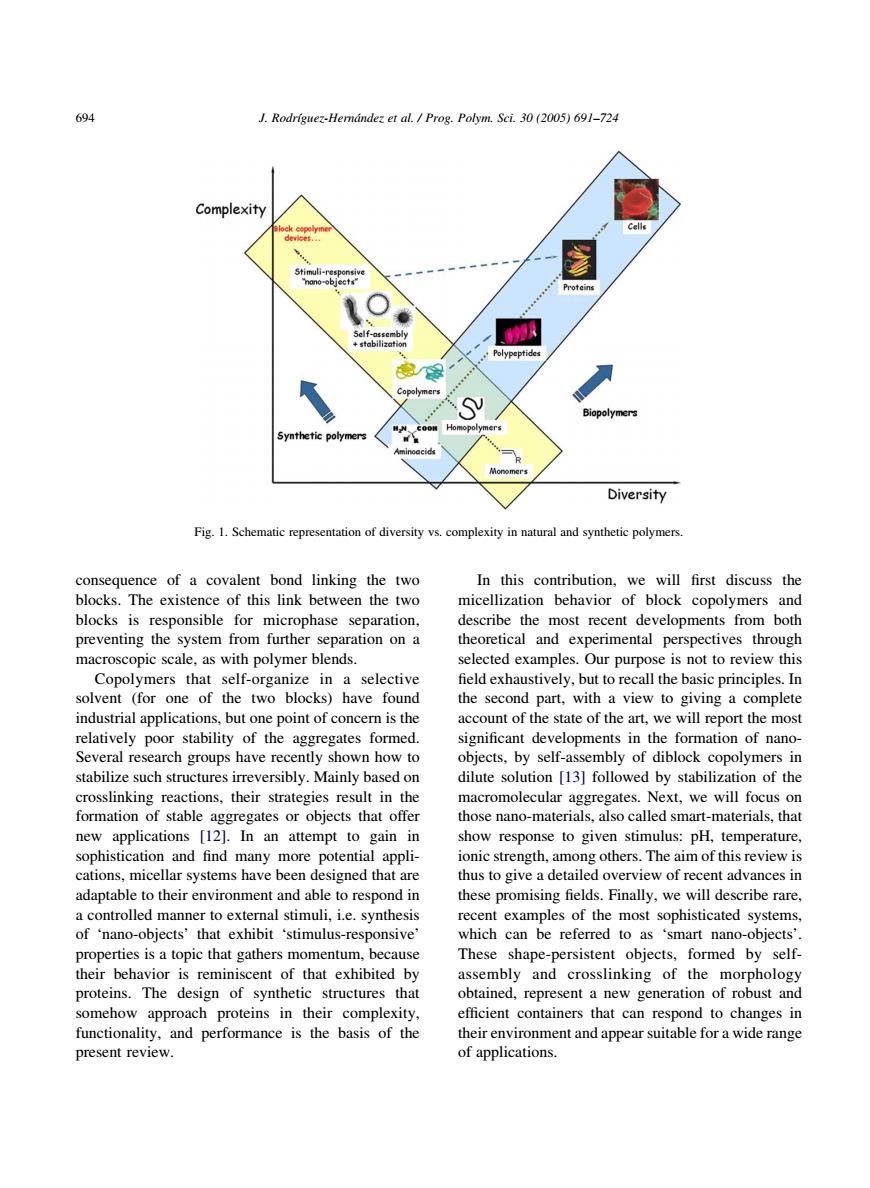正在加载图片...

694 J.Rodriguez-Herdndez et al.Prog.Polvm.Sci.30(2005)691-724 Complexity Diversity Fig.1.Schematic representation of diversity vs.complexity in natural and synthetic polymers. nd linking the two In this bution first discuss The exist this link tween the two CK ponsib opnase opn ation on a sele point of stability of the groups have recentl ly shown how to 0 stabilize such structures irreversibly.Mainly based on crosslinking reactions their strategies result in the macromolecular as gates Next we will focus on formation of stable aggregates or objects that offer those nano-materials.also called smart-materials.that new applications [12].In an attempt to gain in show response to given stimulus:pH.temperature. sophistication and find many more potential appli ionic strength.among others.The aim of this review is cations,micellar systems have been designed that are thus to give a detailed overview of recent advances in adaptable to their environment and able to respond in these promising helds.Finally,we will describe rare a controlled manner to external stimuli,i.e.synthesis recent examples of the most sophisticated systems of 'nano-objects that exhibit 'stimulus-responsive which can be referred to as smart nano-object properties is a topic that gathers momentum because These shape-persistent objects formed by sel remin that exhibited assembly and crosslinking of he gn of morphology ew proteins n ient tainers functionality. that can res nent and appear suit for a wic e range present reviewconsequence of a covalent bond linking the two blocks. The existence of this link between the two blocks is responsible for microphase separation, preventing the system from further separation on a macroscopic scale, as with polymer blends. Copolymers that self-organize in a selective solvent (for one of the two blocks) have found industrial applications, but one point of concern is the relatively poor stability of the aggregates formed. Several research groups have recently shown how to stabilize such structures irreversibly. Mainly based on crosslinking reactions, their strategies result in the formation of stable aggregates or objects that offer new applications [12]. In an attempt to gain in sophistication and find many more potential applications, micellar systems have been designed that are adaptable to their environment and able to respond in a controlled manner to external stimuli, i.e. synthesis of ‘nano-objects’ that exhibit ‘stimulus-responsive’ properties is a topic that gathers momentum, because their behavior is reminiscent of that exhibited by proteins. The design of synthetic structures that somehow approach proteins in their complexity, functionality, and performance is the basis of the present review. In this contribution, we will first discuss the micellization behavior of block copolymers and describe the most recent developments from both theoretical and experimental perspectives through selected examples. Our purpose is not to review this field exhaustively, but to recall the basic principles. In the second part, with a view to giving a complete account of the state of the art, we will report the most significant developments in the formation of nanoobjects, by self-assembly of diblock copolymers in dilute solution [13] followed by stabilization of the macromolecular aggregates. Next, we will focus on those nano-materials, also called smart-materials, that show response to given stimulus: pH, temperature, ionic strength, among others. The aim of this review is thus to give a detailed overview of recent advances in these promising fields. Finally, we will describe rare, recent examples of the most sophisticated systems, which can be referred to as ‘smart nano-objects’. These shape-persistent objects, formed by selfassembly and crosslinking of the morphology obtained, represent a new generation of robust and efficient containers that can respond to changes in their environment and appear suitable for a wide range of applications. Fig. 1. Schematic representation of diversity vs. complexity in natural and synthetic polymers. 694 J. Rodrı´guez-Herna´ndez et al. / Prog. Polym. Sci. 30 (2005) 691–724